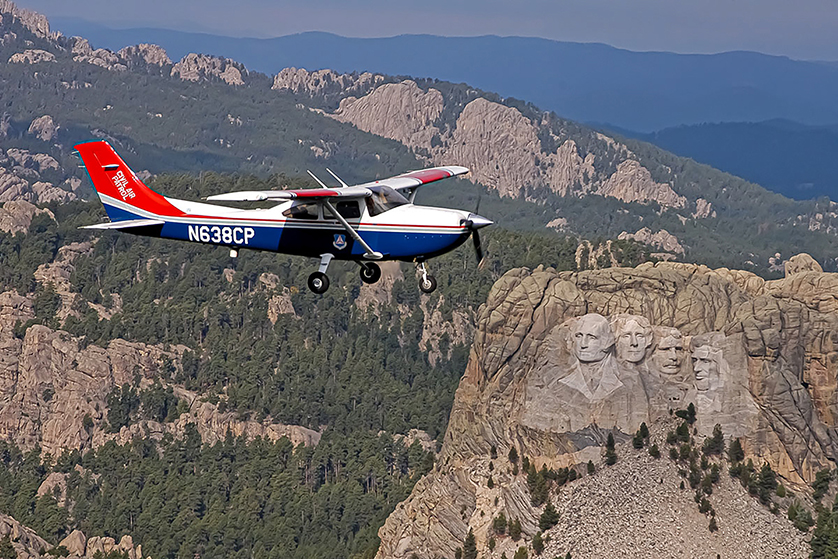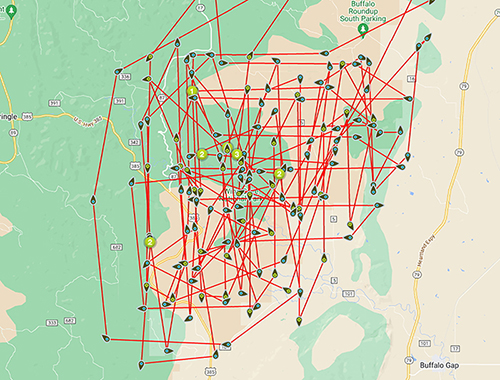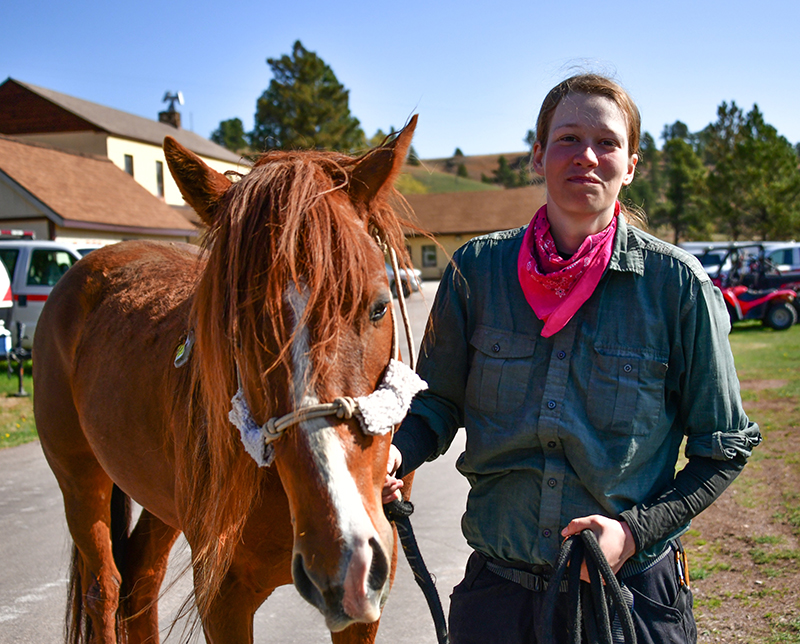
Civil Air Patrol Photo
by Dave Weiman
© Copyright 2023. All rights reserved.
Published in Midwest Flyer Magazine June/July 2023 Digital Issue
The South Dakota Wing of the Civil Air Patrol (CAP) was part of an effort to find a missing horse that broke free from a wilderness camp in Wind Cave National Park on May 2, 2023. Wind Cave National Park is in the southwestern corner of South Dakota in Custer County. It’s known for its vast, underground Wind Cave, with chambers. Many of the cave’s walls are rich in honeycomb-shaped calcite formations known as “boxwork.” The park’s prairie and pine forests are home to bison, elk, and pronghorn antelope. Trails include Rankin Ridge, with views of the Black Hills.
After a series of Facebook postings, someone suggested that the owner of the horse contact the Civil Air Patrol for assistance. The owner had already contacted National Park officials, and a group search was initiated.

Civil Air Patrol Chart
The search allowed CAP members to refine their air-to-ground visual search from fixed-wing aircraft, photography drones, and their ground team.
“The incident was an unusual situation, but one that was similar to a missing person search,” said Craig Goodrich, the Civil Air Patrol Incident Commander, and Vice Commander of the South Dakota Wing. “This mission was a good opportunity to practice searching for a missing person. It also allowed the CAP to work closely with the National Park Service and other agencies, which will enhance all our abilities to work together if we need to look for a missing person at Wind Cave or in the southern Black Hills in the future.”

Civil Air Patrol Photo
The CAP Wing was already in training mode for May under Air Force auspices when they got the call to help in the search.
“The Civil Air Patrol does not usually search for missing livestock,” said Col. Michael Marek, South Dakota Wing Commander. “But we already had training funds scheduled for use this month. We can always use more practice at visual searching in terrain like Wind Cave.”

The horse’s owner, Gin Szagola, 22, of Waxhaw, North Carolina, was riding across the United States and camping in the park at the time. The horse, “Finley,” a 5-year-old Mustang gelding, got away in the middle of the night, pulling a long picket rope. The National Park Service, Custer County Search and Rescue, other agencies, and volunteers began searching for Finley right away, but he was nowhere to be found.
Visitors to the park eventually spotted Finley walking along Highway 385, about two miles from where he went missing a week earlier and led him to the park office where he could be reunited with Gin. Finley appeared to be in good health when found.
In the summer of 2021, Gin contacted a long (distance) rider who goes by the name of “Sea” (https://freerangerodeo.com/) about her interest in crossing the United States on horseback. Sea offered to have Gin move to her farm in the San Juan Islands to learn about horsemanship, while she worked odd jobs babysitting and housekeeping to save up money for her journey. Gin had not ridden prior to this.
“It was really Sea who kickstarted my long-riding dreams with this opportunity,” said Gin. “Growing up, my family bounced around a lot from apartment to apartment. Horseback riding felt out of reach.
“I remember once in high school I inquired about mucking stalls at a barn in exchange for lessons, but the barn wound up being too far away for it to pan out.”
Long-distance riding is not Gin’s first cross-country adventure. She has done quite a bit of cross-country on foot and bicycle as well.
“I walked across America from Delaware to California over nine months in 2019, and cycled across America from Charleston, S.C., to Los Angeles, Calif., then back from Seattle, Wash., to Detroit, Mich., over four months in 2021.
“I cross the country for the love of adventure. It is a life unlike any other. Living on the road keeps your body fit, your mind sharp. It allows you to discover so much about yourself and the world. You connect with so many people you wouldn’t have otherwise connect with. It’s incredibly challenging at times, yes, but that is the secret to it being something worth pursuing.
“It’s rewarding because it’s work. Even if you have a rotten day, every day you’re moving… you’re making real, measurable progress. Even if you have only gotten a mile further, you’re a mile closer to your goal. All the wonder of the United States is around the next bend. You get to see the little things, to appreciate having less. Driving from Point A to Point B, just isn’t the same. And while there is a barrier to entry, it is mostly in your head, and there is a great beauty in that – that this life is waiting for you if you want it enough.
“Part of the reason I am riding across America now is because I hope to become a veterinarian, which means I would have six more years of schooling in store for me! And by the time that’s over, I’ll be at an age most people settle down and have a family which I very much want, too. So, I figure it’s better to get adventuring out of my system while I’m young, before I have too many roots planted.”
Gin will be a junior in college this fall, majoring in Biology. Gin and Finley had to take the winter off because they couldn’t cross the Rockies before snowfall, so they lived in Chadron, Nebraska, while Gin completed some college classes online and worked part time at Ace Hardware.
Where did you get “Finley?”
“I got Finley from a corral in Tennessee that holds adoption events for Mustangs. The Bureau of Land Management, which oversees Mustangs on federal lands, sends truckloads there every few weeks. Finley was originally captured in August of 2021. He is from an area of public land just south of Burns, Oregon, known as the “Palomino Butte” herd management area.
How did “Finley” get away from you?
“Finley was picketed in the backcountry with a hobble (collar) around his front right pastern (ankle), attached to a 50 ft rope. The rope was then connected to a carabiner on a 12-inch stake. Over the last year, I have contained him using this method more than a hundred times with success. It’s critical when I am traveling, so he can graze. In this instance, I happened to doze off nearby, unexpectedly, for no more than 10 to 20 minutes, when he pulled his stake – I’m not sure why – and escaped. It was a terrible stroke of luck.
“The reality is that horses are like dogs and cats. Sometimes they get lost. You accidentally drop the leash or open the front door and ‘Fido’ bolts. Normally you find them wandering nearby. Sometimes you don’t, despite your best efforts. I was shocked when Finley wasn’t found immediately, hung up or grazing within the vicinity of his last known location.
“Staking a horse out, as opposed to tethering them to a stationary object, has its pros and cons. A stake can be pulled in the event of an emergency. That way, if your horse spooks, they are less likely to injure themselves. I opted for a rope with a 244 lb. working load limit for this same reason, so it had the potential to break. I use quick release knots whenever tying, as well, and have kept an ID tag in Finley’s mane. In the future, I will have a GPS locator on him, too. Because while this might have been a freak incident, I am always interested in taking whatever precaution I can going forward, in a world where you can’t prevent everything.”
I understand park visitors found Finley 2 miles from your campsite and contacted National Park officials, who were able to get Finley to the park office area, correct?
“Yes. Finley was spotted Tuesday morning, May 9, around 7:00 a.m. in the vicinity of Wind Cave Canyon Trailhead, adjacent to the maintenance station on Highway 385. Two hikers made contact with him first. Almost immediately, others spotted him from the road. As the bird flies, he was two miles from his last known location.
“He was headed in the direction we entered the park. He had his hobble intact with a foot of rope remaining on it. I remain convinced he was trapped somewhere in the woods for days before freeing himself of the rope. A park staff member ultimately lured him up with the sound of a granola bar wrapper crinkling, and they were able to use a dog leash as a makeshift halter to secure him.”
I have never been to the park, so what is the terrain like?
“Wind Cave National Park is a mixture of open prairie and wooded terrain. There is a variety of wildlife… prairie dogs and buffalo being the two most notable. There are numerous small yet steep canyons throughout the land which makes it difficult to cover on foot effectively. My days searching were spent painstakingly going up and down one hill after another. The majority of these drainages you cannot see from the road. Often, you cannot see one from the next.”
Were you riding through the park or along the highway on your trip?
“Both. We entered the park along Highway 365 and met up with the Centennial Trail.”
Gin Szagola is incredibly grateful for the assistance provided by the South Dakota Wing of the Civil Air Patrol, the National Park Service staff at Wind Cave National Park, the hikers who spotted her horse along the highway, and those who brought him to safety.
About The Civil Air Patrol
Established in 1941, the Civil Air Patrol (CAP) is the official auxiliary of the U.S. Air Force and as such is a member of its Total Force. In its auxiliary role, CAP operates a fleet of 555 single-engine Cessna aircraft, and more than 2,700 small Unmanned Aircraft Systems (sUAS), and performs about 95% of all search and rescue operations within the contiguous United States as tasked by the U.S. Air Force Rescue Coordination Center (AFRCC). Often using innovative cellphone forensics and radar analysis software, CAP was credited by AFRCC with saving 108 lives during the past fiscal year. CAP’s 56,000 members also perform homeland security, disaster relief and drug interdiction missions at the request of federal, state, and local agencies. As a nonprofit organization, CAP plays a leading role in aerospace education using national academic standards-based STEM (science, technology, engineering, and math) education resources. Members also serve as mentors to over 23,000 young people participating in CAP’s cadet programs. Visit https://sdwg.cap.gov/, https://www.cap.news/, or https://www.gocivilairpatrol.com/ for more information about the Civil Air Patrol.
EDITOR’S NOTE: Special thanks to CAP Col. Michael Marek, Tom Farrell of the National Park Service, Gin Szagola, and Jenifer Oimoen for their assistance with this article, and of course, “Finley!”